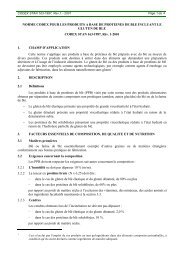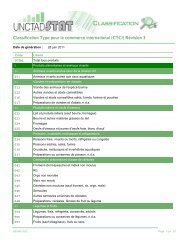12Obvious <strong>cashew</strong> growth deficiencies are not a major problem (unless linked <strong>to</strong> drying <strong>of</strong> flowers)<strong>and</strong> although <strong>the</strong>re is work <strong>to</strong> be done in this area, it is not a high priority.Bush fires <strong>and</strong> <strong>the</strong> subsequent damage <strong>to</strong> <strong>cashew</strong> is one <strong>of</strong> <strong>the</strong> major <strong>constraints</strong> <strong>to</strong> <strong>cashew</strong>production at <strong>the</strong> moment. A comprehensive review <strong>of</strong> <strong>the</strong> literature needs <strong>to</strong> be undertaken <strong>to</strong>see what approaches have been adopted in o<strong>the</strong>r parts <strong>of</strong> <strong>the</strong> world, <strong>and</strong> for o<strong>the</strong>r crops, <strong>to</strong>determine how this can be applied <strong>to</strong> <strong>cashew</strong>, a crop that fruits <strong>to</strong>wards <strong>the</strong> end <strong>of</strong> <strong>the</strong> dry seasonwhen fires are at <strong>the</strong>ir most devastating.Cashew has a very valuable role <strong>to</strong> play in bush fire reduction in general, because it yields in <strong>the</strong>dry season. Experience in o<strong>the</strong>r countries has shown that as a ‘<strong>cashew</strong> culture’ develops, withmore <strong>and</strong> more farmers growing <strong>cashew</strong>, fires are almost au<strong>to</strong>matically brought under control.A closer look at <strong>the</strong> economics <strong>of</strong> high density planting is required <strong>and</strong> should be undertaken inall <strong>the</strong> countries, since yield potentials <strong>and</strong> input costs (such as labour for weeding), will varyconsiderably.2.3 Constraints <strong>related</strong> <strong>to</strong> breeding, planting material <strong>and</strong> researchThe previous section gave a realistic picture <strong>of</strong> <strong>the</strong> major biotic <strong>and</strong> environmental <strong>constraints</strong> <strong>to</strong><strong>cashew</strong> production in <strong>the</strong> region, on which breeders can start selecting resistant or <strong>to</strong>lerant types,in addition <strong>to</strong> <strong>the</strong> normal characteristics <strong>of</strong> good yield <strong>and</strong> quality.There follows a brief review <strong>of</strong> existing germplasm <strong>and</strong> what breeding work has been carried outin individual countries. GuineaThe “original” germplasm collection at CRAF (Centre de Recherche Agronomique de Foulaya)was a group <strong>of</strong> sixty-one old trees, planted as seed in <strong>the</strong> 1950s. Although originally planted at agood spacing, <strong>the</strong> trees are now somewhat over-crowded. The source <strong>of</strong> <strong>the</strong>se trees is unknown,although Tanzania <strong>and</strong> Mozambique have been suggested as possibilities. The reason for <strong>the</strong>irselection is also unknown; at <strong>the</strong> time <strong>of</strong> planting <strong>the</strong>ir purpose might have been for forestry, orjust <strong>to</strong> have <strong>cashew</strong> on <strong>the</strong> research station for student studies. Characterisation <strong>of</strong> <strong>nuts</strong> from<strong>the</strong>se trees has started.A second germplasm collection at Kankan consisted <strong>of</strong> seed from some <strong>of</strong> <strong>the</strong> original Foulayacollection <strong>and</strong> seed from a few selected trees in <strong>the</strong> region. These trees were planted veryrecently, in 1998 <strong>and</strong> 1999. There were no replicates <strong>and</strong> <strong>the</strong> researchers did not know how manytrees were surviving (although this appeared <strong>to</strong> be low).The only new plant material <strong>of</strong> known provenance recently introduced in<strong>to</strong> Guinea was seed fromBrazilian clones CCP 09, CCP 1001 <strong>and</strong> CCP 076. Unfortunately, only small percentages havegerminated. These seeds were imported without any quarantine procedures. This is potentiallyvery dangerous, as Brazil has <strong>cashew</strong> pests <strong>and</strong> diseases that are not found in West Africa.Before importing more <strong>cashew</strong> seeds from o<strong>the</strong>r countries, especially outside <strong>of</strong> West Africa,suitable quarantine procedures must be put in<strong>to</strong> place.A new germplasm trial at Boke has been planted from seed, <strong>and</strong> so all <strong>the</strong> new plants were halfsiblings<strong>and</strong> not clones <strong>of</strong> <strong>the</strong> original mo<strong>the</strong>r trees. New material included seed from:• <strong>the</strong> best trees in <strong>the</strong> “original” collection,
13• selected mo<strong>the</strong>r trees from Boke region,• Brazilian seed originating from a forestry project (nothing more is known aboutthis source).At Foulaya, research technicians have started practising grafting <strong>cashew</strong> plants. However, so farall germplasm material planted has been derived from seed; no vegetatively produced seedlingshave been used.There was confusion amongst some people as <strong>to</strong> why trees grown from seed were called halfsiblings<strong>and</strong> not clones, <strong>and</strong> also about what constitutes a clone. Guinea BissauLocal researchers contacted were not aware <strong>of</strong> any imported planting material (it was suggestedthat <strong>the</strong> company Agri-Bissau had imported seed from Brazil, but this was not <strong>the</strong> case). AUSAID funded project wanted <strong>to</strong> import <strong>cashew</strong> from Brazil, but this was refused on quarantinegrounds.Farmers were planting local seed <strong>and</strong> some were selecting on <strong>the</strong> basis <strong>of</strong> nut size. ADDP (anNGO from Denmark) was also selecting local seed for planting based on nut size.In 1994 <strong>and</strong> 1995, <strong>the</strong> Agri-Bissau estate selected seed for planting from an old plantation atQuihamel. Since <strong>the</strong>n <strong>the</strong>y have selected seed from <strong>the</strong>ir own plantation. The criteria forselection <strong>of</strong> seed were nut weight, tree structure <strong>and</strong> intensive branching.Agri-Bissau was experimenting with side grafting <strong>of</strong> precocious trees. Apart from this veryminor experimental testing, <strong>the</strong>re appeared <strong>to</strong> be no practical use made <strong>of</strong> vegetative propagationtechniques in Guinea Bissau.The reports by Camara <strong>and</strong> Vayssie (1996 <strong>and</strong> 1997) provide considerable information about nutweightdata, some <strong>of</strong> which is summarised in <strong>the</strong> following table.Percentage distribution <strong>of</strong> raw nut weights from Guinea BissauCategory Cajui TrèspetitesPetites Moyennes Gr<strong>and</strong>es Trèsgr<strong>and</strong>esWeight range 15.00g1995/96 10 32 51 7 01996/97 6 28 54 12 0Average 8 30 52.5 9.5 0Source: Data from Camara <strong>and</strong> Vayssie (1997)Data in <strong>the</strong> table show that from <strong>the</strong> average <strong>of</strong> <strong>the</strong> two seasons’ samples, 38% <strong>of</strong> <strong>nuts</strong>, i.e <strong>the</strong>grade termed “très petites’ (very small) weighed less than 4.5g, Moreover, around 60% <strong>of</strong> raw<strong>nuts</strong> weighed less than 5.00g.The fact that <strong>nuts</strong> from Guinea Bissau are generally small was also reported at <strong>the</strong> 2001 WorldCashew Congress in India <strong>and</strong> yet, in spite <strong>of</strong> <strong>the</strong>ir small size, <strong>the</strong>y comm<strong>and</strong> a premium on <strong>the</strong>international market. The reason for this is <strong>the</strong> high percentage kernels out-turn <strong>of</strong> <strong>nuts</strong> from


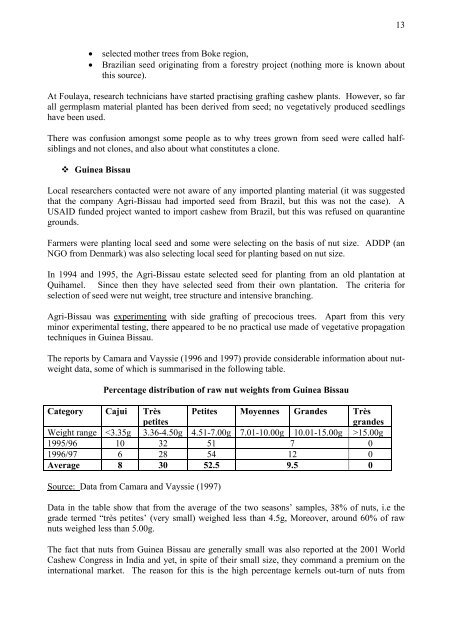
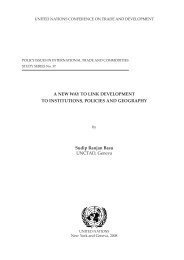
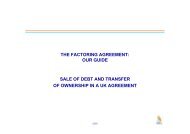
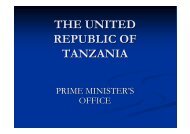
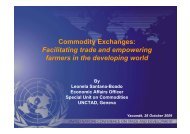
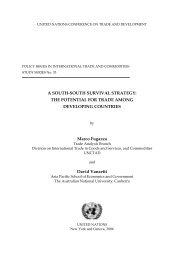
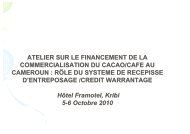
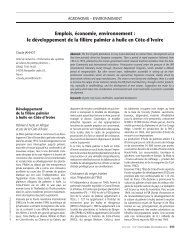
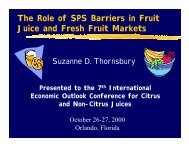
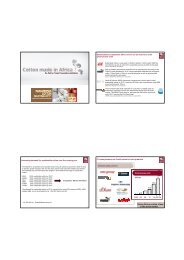
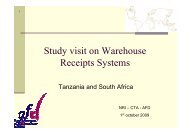
![Warehouse Receipt Systems: Legal Issues [PDF]](https://img.yumpu.com/43979338/1/190x134/warehouse-receipt-systems-legal-issues-pdf.jpg?quality=85)
